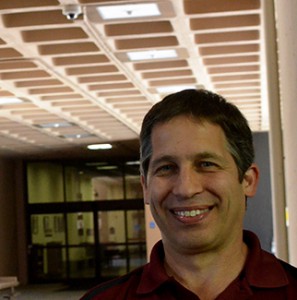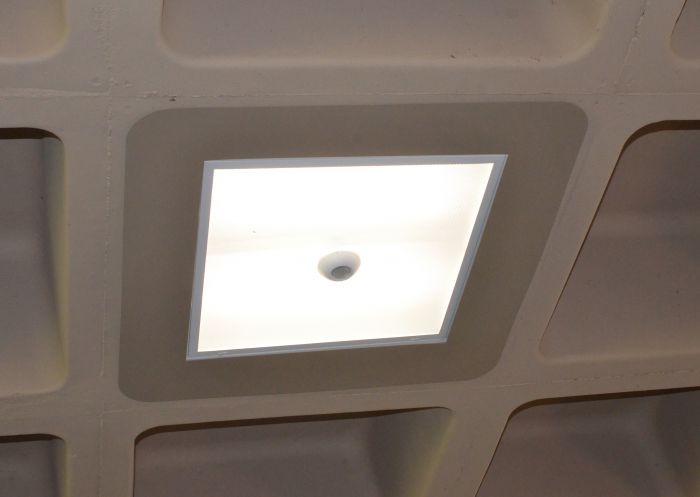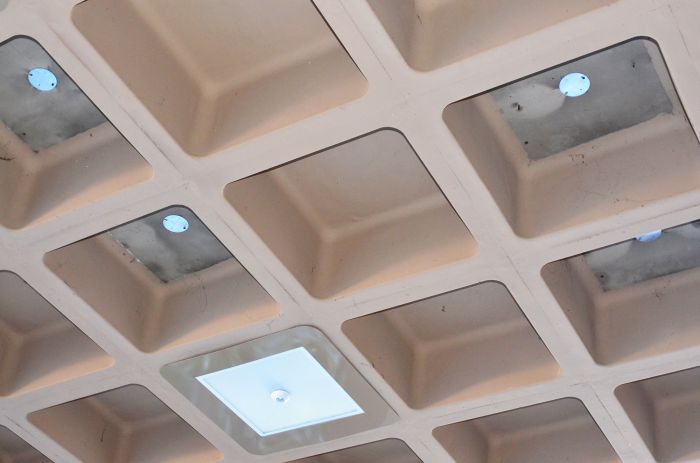
California State University, Dominguez Hills (CSUDH) will be honored with the 2015 California Higher Education Energy Efficiency and Sustainability Best Practices Award for its new LED outdoor ceiling lighting system during the California Higher Education Sustainability Conference (CHESC).
Hosted by San Francisco State University on July 20-24, a total of nine California State University (CSU) campuses will receive the coveted sustainability awards in 12 categories at the conference.
CSUDH will receive an award in the “Lighting Design/Retrofit” category for a creative solution it came up with to improve the lighting in a challenging ceiling design that is found in a number of its buildings. The Leo F. Cain Library, the Natural Science and Mathematics (NSM) building, and LaCorte Hall (LCH), all designed by CSUDH’s master architect A. Quincy Jones, feature a distinctive honeycomb ceiling with deep recesses.
“The honeycomb architecture turned out to be very inefficient for lighting. Before our updates, there was a light in every fourth honeycomb. Now there are three-quarter fewer lights, but we have much better lighting and are saving a good amount of energy and money,” said Kenny Seeton, CSUDH Central Plant and energy manager, who led the cost- and energy-saving lighting project, which was completed in December 2014.
Seeton had to design custom housings for the unusual architectural feature to secure the lights in place and ensure they are safe to walk under.

“I spent about three years talking to vendors; I was looking for a good solution. All they wanted to do was sell us the same type of lights or pendant fixtures that would hang down from the ceiling, but that would just create spots for birds to nest,” he said. “I eventually found a vendor we could work with. I had the idea of creating something similar to indoor lights with ceiling tiles. I realized we could just make our own frames and then bolt them up. We spent hours working on the design ourselves. I’m pretty proud about that.”
The project resulted in the replacement of 441 58-watt u-tube fluorescent fixtures with 179 45-watt LED fixtures that feature Enlighted Smart programmable occupancy controls that Seeton can set from his iPad. The estimated annual energy savings of the new lights is 101,188 kilowatt hours, with an annual cost savings of close to $13,000. The university spends approximately $100,000 a month on electricity.
Set at 100 percent, the new lights draw 45 watts of electricity, but they never require full energy capacity to provide sufficient lighting and typically run at only 10 percent until the motion sensors detect movement and increase the output to 50 percent or less, according to Seeton, who will accept the award at the conference on behalf of CSUDH.
The CHESC awards, which are jointly organized by independent and private colleges, and the California Community College, CSU and University of California (UC) campus systems, recognize innovative project teams for implementing sustainable practices that can be replicated at other campuses to conserve natural resources. Last year, CSUDH took the best “Lighting Design/Retrofit” award at CHESC, also for intelligent lighting controls implemented on campus, and a monitoring-based commissioning award for energy saving methods implemented at the university’s main administration building, Welch Hall.

Seeton and his team have additional plans to increase the number of LED lights on campus, as well as start other projects to help save energy and money. The university has approximately a quarter-mile of underground tunnels which will also be replaced with LED lighting and sensors.
In addition, all of the lighting in the South Academic Complex 1 (SAC-1) and the office spaces in SAC-2 will be replaced. They will also connect air-conditioning units in the buildings to the sensors to reduce their use when there are fewer people on campus, such as during spring and winter break.
“In the past we had the air-conditioning in SAC on from 7 a.m. to 10 p.m. and six days a week because we didn’t know when people were going to be there. That’s one of the projects I’m most excited about,” said Seeton. “There will also be some classrooms remodeled during this summer that will get the new lighting technology put into them.”